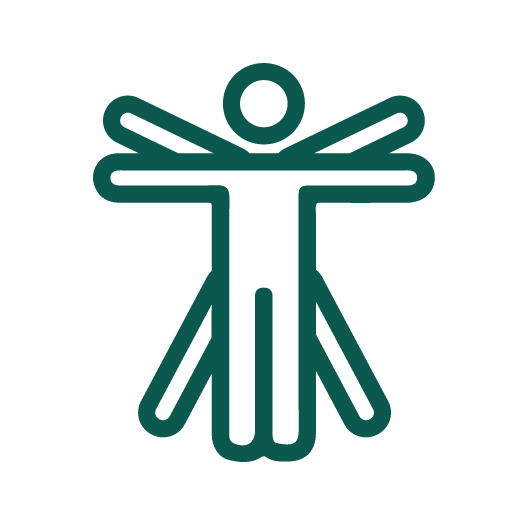
Saprea Support Groups > Group Materials >Body Kindness
Group Activity
Progressive Muscle Relaxation
Body kindness is about redirecting feelings of shame or judgment about your body towards feelings of acceptance and self-compassion. One way you can begin this shift is by noticing all the ways your body serves you. Even though it may be difficult, taking the time to appreciate all the parts of your body, even the parts you may not usually have positive thoughts about, can help strengthen your body kindness.
This type of appreciation can be small—as small as, “Today my skin helped me feel the warm sunlight,” or “My neck helped me to look at the sky this morning.”
In this activity, you can practice observing how your body serves you with a relaxation technique called Progressive Muscle Relaxation (PMR). We’ve used this technique before as a grounding exercise. Today we’ll spend a little more time on what PMR is and how it can serve as not only a grounding exercise but also a way to practice body kindness and connection.
Progressive muscle relaxation is an exercise centered around tensing and releasing your major muscle groups in order to learn to notice, appreciate, and relax those muscles. Not only can this exercise help relieve tension and improve your ability to relax, but it can also help draw your attention to parts of the body that may generally go unnoticed. PMR is often used to promote a calmer, more relaxed emotional and/or physical state. It helps reduce stress, anxiety, muscle tension, and has been known to ease some chronic pain. Because of this, it’s often prescribed as a sleep technique, but it is also effective to reduce tension, to become aware of body sensations, and to remind the body that a calm or more relaxed state can be safe.
So let’s get started!
Activity steps
Option 1—PMR Script
Group Leader A guides the participants in a PMR meditation by reading through the script provided below. This exercise is roughly 10 minutes long and may be adjusted to fit the time constraints of the group.
Guided Meditation Script
Let’s begin by getting comfortable – either sitting up or lying down, knowing that either is fine so long as you are comfortable and fully supported. During this practice, you’re welcome to find a focal point at which to softly gaze, or you may find yourself closing your eyes and going inward; again, either is fine, so long as you remain comfortable and present.
When you are ready, I invite you to draw your attention to your breath; and as you do, notice the breath that is happening right now. As you breathe, notice how your abdomen rises and falls with each breath… notice the air flow in… and the air flow out…
Take as many deep breaths as feels right… [pause]
You may notice that your body has already undergone a change; perhaps you notice a stillness or calm, or perhaps the tension in your body is beginning to subside. For now, let your breathing resume its normal pace.
… I invite you to bring your awareness to your feet and toes. Breathe in deeply through the nose, and as you do, slowly curl your toes downward, tensing the muscles in your feet. Hold both the breath and contraction for a few seconds, and then release the muscles in your feet as you breathe out… Notice the different sensations in your feet and toes when they are tense and when they are relaxed; remembering to keep the observation simple and kind—no judgment, rather just observing with curiosity… Once again, I invite you to inhale deeply and as you do, slowly curl your toes downward. Hold for just a moment…and now exhale, releasing the contraction and letting the muscles of the feet relax …
And now, let’s bring your awareness to your leg muscles – the calves. When ready, breathe in gently and deeply as you flex your feet, pointing the toes upward, and feeling tension in your calves. Hold for just a moment, and then breathe out, letting the muscles relax and the tension wash away… Once again, take a deep breath in as you flex your feet and point the toes upward, feeling tension in your calves. Hold for a few seconds, and then breathe out, letting your calf muscles relax and become heavy.
And now, let’s bring your attention to your upper leg muscles, the quadriceps and hamstrings. When ready, take a deep breath in and as you do, gently contract your upper leg muscles. Hold the breath and contraction for just a few seconds, and now exhale as you release the contraction, letting the tension fade away… Once again, take a deep breath in and as you do, contract the upper leg muscles. Hold for just a moment, and now exhale, allowing the air to flow out and allowing the legs to relax and grow heavy.
I invite you to bring your awareness to your abdomen. When ready, take a deep breath in while tensing the stomach. Perhaps imagine yourself attempting to touch your belly button to the spine. Hold that tension and breath for just a moment, and then exhale, allowing the stomach to relax and to just be… Once again, take a deep breath in, and as you do, tighten the stomach muscles once more. Hold for just a moment. And now, exhale – letting the air flow out and letting the abdominal muscles relax completely.
Next, let’s bring your awareness to your neck and shoulders. Perhaps notice any tension or sensation that may be there already... When ready, take a deep breath in through the nose, lifting your shoulders to the ears. Hold for a moment, and then exhale – lowering the shoulders and letting them relax completely as the air flows out... Once again, take a deep breath in through the nose, raising your shoulders to the ears. Hold for a moment. And now, exhale; letting the air flow out as your shoulders drop and grow heavy.
And now, let’s give the arms and hands opportunity to learn to relax. When ready, deeply inhale and as you do, bring your fists to your shoulders, squeezing your arms and hands. Hold for just a moment. And now exhale completely, letting your arms ease and hands open. You may notice some light tingling or throbbing in your arms or hands; rest assured this is normal. Simply notice the sensation wash away as your muscles drift into a more relaxed state… Once again, deeply inhale as you bring your fists to your shoulders, squeezing both arms and hands. Hold for just a moment. And now, exhale completely, letting your arms drop to your lap or sides and letting your hands open… Perhaps noticing the tension wash away as your breath resumes its natural pace…
Let’s now bring an awareness to the facial muscles. As you inhale, clench your jaw, and perhaps furrow your brow. Hold the breath and contraction for a moment, and now exhale as you release those muscles… Notice the muscles softening and the expression loosening… Again, slowly inhale and gently clench the jaw and furrow the brow, hold for a moment, and then release; letting your breath gently flow out and the facial muscles ease…
At this time, you may wish to notice an overall sensation of heaviness or relaxation in the body. Feel free to take a few more deep breaths, or simply let yourself be as you find yourself in this relaxed state… [pause]
… Take a moment to reflect on a specific muscle or muscle group that we focused on and note how it has helped you today. When you are ready, wiggle your toes, wiggle your fingers, gently open your eyes.
Option 2—PMR Video
Grounding Exercise
Self-Kindness Meditation
Activity Steps
01
02
03
04
Hosting Your Meetings Off-Line? Download All of the Materials You Need Here:
Additional Resources
Done With This Topic? Jump to the Next.

Introducing Acknowledgement

Trauma’s Impact on the Brain and Body

